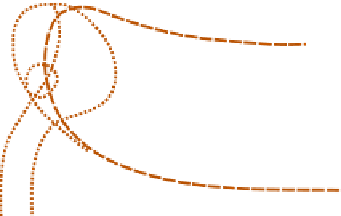Geoscience Reference
In-Depth Information
10
5
0
5
10
15km
High altitude
wind shear
Cloud outline
50
15
Moist warm
updraughts
40
10
Typical
hail paths
30
Storm
advancing
20
Tornadoes
form here
5
10
Dry cold
downdraughts
0
0
5
0
5
8 miles
Hail
Heavy rain
Wind gust
front
Squall
line
Figure 9.28
Thunder cell structure with hail and tornado formation.
Source: After Hindley (1977). By permission of New Scientist.
sufficiently extensive they create a local high
pressure of a few millibars' intensity. The
downdrafts trigger the ascent of displaced warm
air, and a general warming of the middle tropos-
phere results from latent heat release. Inflow
develops towards this warm region, above the cold
outflow, causing additional convergence of moist,
unstable air. In some cases, a low-level jet provides
this inflow. As individual cells become organized
in a cluster along the leading edge of the surface
high, new cells tend to form on the right flank (in
the Northern Hemisphere) through interaction
of cold downdrafts with the surrounding air.
Through this process and the decay of older cells
on the left flank, the storm system tends to
move 10-20
readily identified on infrared satellite images.
Statistics for 43 systems over the Great Plains in
1978 showed that the systems lasted on average
12 hours, with initial mesoscale organization
occurring in the early evening (18:00-19:00 LST)
and maximum extent seven hours later. During
their life-cycle, systems may travel from the
Colorado- Kansas border to the Mississippi River
or the Great Lakes, or from the Missouri-
Mississippi River valley to the east coast. An
MCC usually decays when synoptic-scale features
inhibit its self-propagation. The production of
cold air is shut off when new convection ceases,
weakening the meso-high and -low, and the
rainfall becomes light and sporadic, eventually
stopping altogether.
Particularly severe thunderstorms are associ-
ated with great potential vertical instability (e.g.,
hot, moist air underlying dryer air, with colder air
aloft). This was the case with a severe storm in the
vicinity of Sydney, Australia, on 21 January 1991
(
Figure 9.30
). The storm formed in a hot, moist,
low-level airstream flowing northeast on the
eastern side of the Blue Mountains escarpment.
This flow was overlain by a hot, dry, northerly
airstream at an elevation of 1500-6000 meters,
to the right of the mid-tropospheric
wind direction. As the thunderstorm high
intensifies, a 'wake low', associated with clearing
weather, forms to the rear of it. The system is now
producing violent winds, and intense downpours
of rain and hail accompanied by thunder. During
the triggering of new cells, tornadoes may form as
discussed below. As the MCC reaches maturity
during the evening and night hours over the Great
Plains, the mesoscale circulation is capped by an
extensive (>100,000km
2
) cold upper-cloud shield,
°











































































































